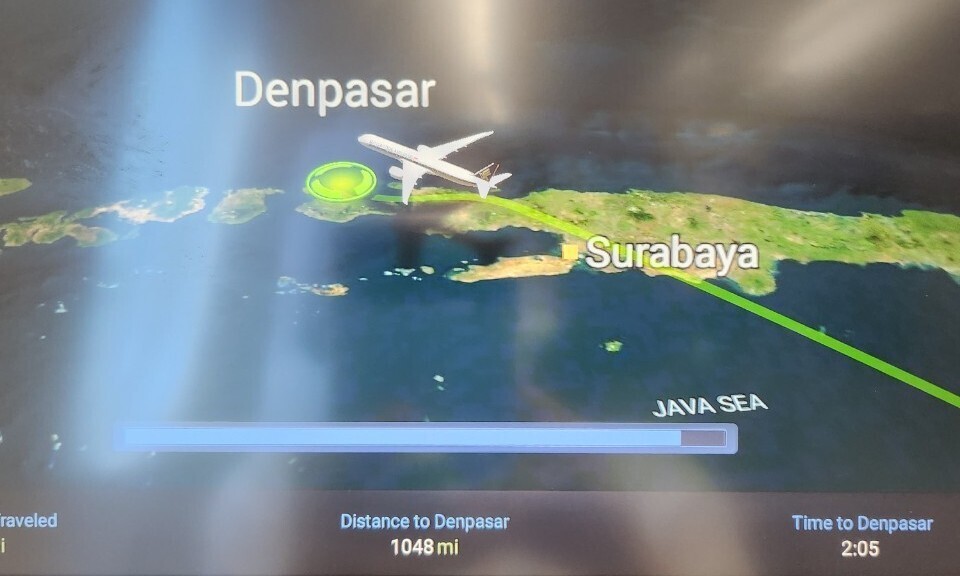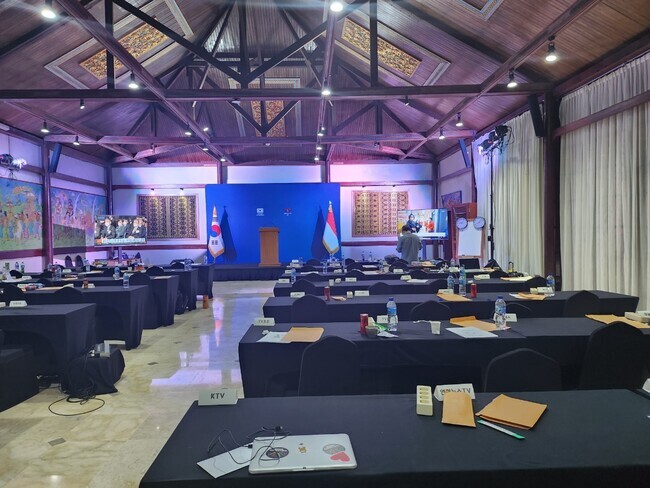hankyoreh
Links to other country sites 다른 나라 사이트 링크
How a Hankyoreh reporter covered Yoon’s SE Asia tour without presidential jet access

At around 7 pm on Nov. 10, one day before President Yoon Suk-yeol’s trip to Southeast Asia, I boarded an Asiana commercial aircraft from Incheon to Phnom Penh, Cambodia. As a member of the presidential office press pool, I was originally meant to go to Phnom Penh aboard the presidential jet together with the president on the morning of Nov. 11, but an unexpected turn of events ended up completely changing my travel plans.
On the night of Nov. 9, two days before we were set to depart for the president’s Southeast Asia tour, the presidential office notified MBC — the broadcaster that was the first to report Yoon’s New York hot mic moment in September — that its reporters would not be allowed to board the presidential jet.
In protest of the presidential office’s clear attempt to control the press, the Hankyoreh decided the next day that its reporters would boycott use of the presidential plane for this tour.
Since then, I've been extremely busy. First, I had to quickly retrieve my luggage which was to be sent to the presidential jet from the presidential office. I then looked for the earliest commercial flight to Phnom Penh. However, there were no economy seats left.

For the first time in my life, I booked a business class seat on a flight that was scheduled to leave at 7:25 pm that night. This is how my coverage of this unprecedented situation began one day before the president left for his tour.
The next day, on the afternoon of Nov. 11, the other reporters who arrived on the presidential jet got together at the hotel where the press center was set up.
Although the presidential office emphasized that the exclusion from boarding the presidential jet posed “no restrictions on news coverage at all,” flying commercial brought up all kinds of obstacles for reporting throughout the president’s tour.
First of all, it was impossible to keep up with the president's movements since he was flying on the presidential plane. For example, after he finished his schedule in Cambodia on the night of Nov. 13, the president immediately boarded his jet and flew to Bali in a matter of four hours.
However, there were no flights out that evening, so I arrived in Bali via Singapore the next day, on Nov. 14. First, I had to wait about four hours at the airport in Phnom Penh and even got hit with a one-hour delay before takeoff. The flight from Phnom Penh to Singapore then took two hours and five minutes. Once I was in Singapore, I had to wait another two hours before flying for two hours and 45 minutes to Bali. In all, it took me more than 10 hours to get from the airport in Phnom Penh to the airport in Bali.

By the time I was boarding my flight to Bali, however, Yoon was already giving his keynote speech in Bali at the B-20 summit attended by representatives of economic organizations and businesses from countries belonging to the Group of 20 (G-20). I ended up arriving at the press center in Bali at 8:30 pm, having missed all the presidential office briefings for that day.
It was not until later that I finally received a handbook for reporting on the president’s itinerary and major events. I had very limited power to gather information in this environment and I was totally disoriented.
But it wasn't all hardship and discomfort. A Korean I met in Bali, for example, told me how they supported the Hankyoreh’s decision to refuse to board the presidential jet.
On the night of Nov. 15, after Yoon’s tour was over, the press corps proceeded to the airport while I was once again left behind at the empty press center.
The space was desolate with only some press releases, bottled water, power adaptors, and the South Korean and Indonesian flags left on the podium.
Commercial flights to Seoul were all full that night. I had to stay one more night and was scheduled to catch an early Korean Air flight the next day to arrive in Seoul on the morning of Nov. 17.
My coverage of the president’s Southeast Asia tour, which began one day earlier than the president’s schedule, also ended one full day later. While the president’s schedule was four nights and six days, mine ended up being six nights and eight days.

Postscript:
It still remains unknown for how long the presidential office’s unprecedented decision to exclude reporters from certain media outlets from boarding the presidential plane will remain in force. According to the presidential office, there is “no set policy” regarding the issue. The possibility also exists that this exclusion may be extended to other media outlets as well. This time, the restriction on covering the president’s movements was limited to an aircraft, but it remains to be seen whether the scope of such restrictions will be further extended in the future.
By Bae Ji-hyun, staff reporter
Please direct questions or comments to [english@hani.co.kr]

Editorial・opinion
![[Editorial] Yoon must halt procurement of SM-3 interceptor missiles [Editorial] Yoon must halt procurement of SM-3 interceptor missiles](https://flexible.img.hani.co.kr/flexible/normal/500/300/imgdb/child/2024/0501/17145495551605_1717145495195344.jpg) [Editorial] Yoon must halt procurement of SM-3 interceptor missiles
[Editorial] Yoon must halt procurement of SM-3 interceptor missiles![[Guest essay] Maybe Korea’s rapid population decline is an opportunity, not a crisis [Guest essay] Maybe Korea’s rapid population decline is an opportunity, not a crisis](https://flexible.img.hani.co.kr/flexible/normal/500/300/imgdb/original/2024/0430/9417144634983596.jpg) [Guest essay] Maybe Korea’s rapid population decline is an opportunity, not a crisis
[Guest essay] Maybe Korea’s rapid population decline is an opportunity, not a crisis- [Column] Can Yoon steer diplomacy with Russia, China back on track?
- [Column] Season 2 of special prosecutor probe may be coming to Korea soon
- [Column] Park Geun-hye déjà vu in Yoon Suk-yeol
- [Editorial] New weight of N. Korea’s nuclear threats makes dialogue all the more urgent
- [Guest essay] The real reason Korea’s new right wants to dub Rhee a founding father
- [Column] ‘Choson’: Is it time we start referring to N. Korea in its own terms?
- [Editorial] Japan’s rewriting of history with Korea has gone too far
- [Column] The president’s questionable capacity for dialogue
Most viewed articles
- 1Months and months of overdue wages are pushing migrant workers in Korea into debt
- 2Trump asks why US would defend Korea, hints at hiking Seoul’s defense cost burden
- 3At heart of West’s handwringing over Chinese ‘overcapacity,’ a battle to lead key future industries
- 4[Editorial] Yoon must halt procurement of SM-3 interceptor missiles
- 5Fruitless Yoon-Lee summit inflames partisan tensions in Korea
- 6Dermatology, plastic surgery drove record medical tourism to Korea in 2023
- 71 in 3 S. Korean security experts support nuclear armament, CSIS finds
- 8AI is catching up with humans at a ‘shocking’ rate
- 9First meeting between Yoon, Lee in 2 years ends without compromise or agreement
- 10[Guest essay] Maybe Korea’s rapid population decline is an opportunity, not a crisis